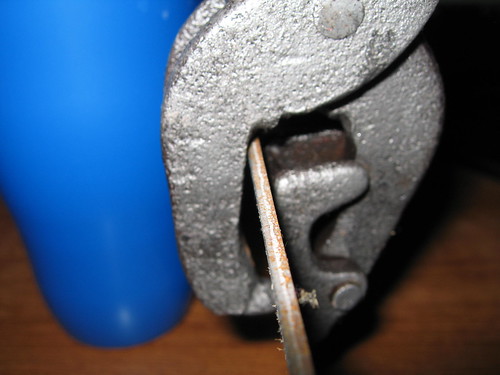-
Posts
74 -
Joined
-
Last visited
Content Type
Profiles
Forums
Articles
Gallery
Downloads
Events
Posts posted by sstreckfuss
-
-
Welcome Badger1875!
-
I have the Diamondback Ironworks 2 burner model and like it a lot although I am new to this craft and really don't have anything to compare it to.
Heres a like to their site.
http://www.diamondbackironworks.com
Copyrighted photo removed and link inserted. -
Hello from St. Louis!
-
Cool thanks for all the input guys. I doubt I will ever mess with a plow shear but I am sure i will find something else to use these for.
-
Thats only a 3 hour drive from my house...I'll be watching the auction thats for sure...
-
ool! Those are very similar, I almost guarantee they are from the same manufacturer. Mine are unique to those also in the fact that the swivel jaw arm of the tong passes through the toothed arm, it also has an arc and valley to the toothed portion that yours lack. I am intrigued....
Have you found a use for yours? -
The tongs jointed element wont open up far enough to get anything greater than a no. 2 pencil in it as you show Czar.
Here is a little animated gif I made showing the relationship between the "tooth" and the jointed element.
-
Yeah czar the tooth is a bit mangled, they were nearly rusted shut when I got them, I bead blasted them yesterday and thats when I noted their odd design. The damage may just be from rusting away, at least partly.
I bought these in a 5 gallon bucket of tongs at an auction put them in the corner and just got to cleaning them up and going through them.
I have another pair of tongs from the same bucket that I am pretty sure is wrought iron that I was going to post pics of for confirmation but hadn't got around to it. -
I don't have any big chain, it might hold it well, it won't clamp onto anything very small.
Your chain idea got me thinking that it might hold a horseshoe pretty tight if the shoe was deeper than the tooth and the tooth would keep it from slipping out. I'll have to get ahold of a horseshoe and give it a try. :cool:
Heres a pic of it holding some sheet metal I had lying about, it actually holds it fairly tight though It doesn't feel "right".
-
-
-
-
Here is a post from a couple of months ago about that very subject. If you do a search you should come up with a couple more as well.
-
I agree with the above, the moveable side should be towards you in your scenario, although we all know that sometimes you just have to use it backwards to overcome clearance issues.
BTW a 'Crescent' (adjustable) wrench is a brand name, as is an 'Allen' wrench (hex key), or 'channel lock' (slip jont) pliers, I am sure there are more out there but can't think of any off the top of my head. -
I fix choo choos as my 3 year lets it be known.
-
Google image search for "portable forge" yields a lot of good designs.
Link -
Any fastener can be retained with what some call French-locks or Tab-locks. These are washers that have two or more long tabs that extend outward and are placed under the head of the bolt before it is threaded in. Once torqued down, one tab is bent downward over the edge of the piece, while the other is bent upward and over one flat of the bolt head. A common place to see these was on the small block Chevys up to the mid-70's. Another common place is where a PTO has been installed on a manual transmission (these washers are almost always included in the Eaton and Chelsea brand kits). As for placing them where there is no edge to bend downward, drilling a shallow hole in the surface a short distance away from the bolt hole will allow you a point to which you can push part of the tab into.
I hope this helps.
We use these at my work on aluminum housings that have stainless bolts on them. I am assuming that this is due to the low toque value used so as not to strip out the threaded aluminum housing. I have never seen one fail although when in their final assembly state they have little stress. They are sometimes a pain to install though as they like to slip to a nonperpendicular location (flat part of tab not located at the flat part of the housing where it is to be bent over). Sorry if that is not clear. -
I usually just put irregular stuff into my machinist vise at work and clamp my grounding clamp to the vise body. May not be orthodox but works well for me and works for any/all irregular shaped items without modification to the actual item. :D
-
The "ballast" used on Metrolinks railroad bed is iron ore slag, or so I am told. I don't know why other than what I was told, "it is cheap". It does not look like what you have pictured although it may be related. It is actually a bad choice for electric train track ballast due to it being conductive and easily ground up into a fine dust. The dust literally coats every electrical componenet on the trains and is a major mess to deal with. Our ballast is a reddish brown color that is flaked and chipped into gravel size chunks, some of it is pourous like lava rock.
-
I talked with the guy in the gearbox rebuild shop today and he does use a combination of heating the bearings and hydraulic pressure to install his bearings. He heats the bearings to 200 degrees farenheidt.
-
We install "tight fit" bearings regularily at the train repair yard. We do alot of tight fit installs that are not bearings as well.
We do not freeze the shafts nor heat the bearings at all, although we do heat a stop plate prior to installation on the axle bearing install, but not the bearing itself.
We ensure the shafts are free of debris and high spots visually, any burs are emery clothed out. The bearings are pressed on with a hydraulic cylinder using slow but steady pressure, the shaft is dry although the inner portion of the bearing is coated with a thin layer of grease. The hydraulic pressure is being applied to the inner race of the bearing transfered though a properly machined sleeve.
That being said there is a gearbox bearing install that may be heated before install, I will have to ask the guy in charge of the rebuild area. I know he uses hydraulics as well to install but he may heat prior to that install. -
Thats cool...doesn't look easy at all.
-
I have a plain hobart helmet that I painted as well...I'll have to take a pic...although I just painted it blue....
-
While dry ice blasting might be cost prohbitive to get into I've been readin about Bicarbonate of Soda blasting, cleans up with a garden hose...it might do what you need plus less cleanup than glass bead...
Heres a link to eastwoods setup...


 )
)
Welding nuts or bolts to metal
in Welding/Fab General Discussion
Posted
I use the exact same method except I use masking tape in place of duct take, we don't have duct tape laying around the shop or I would probably use it.